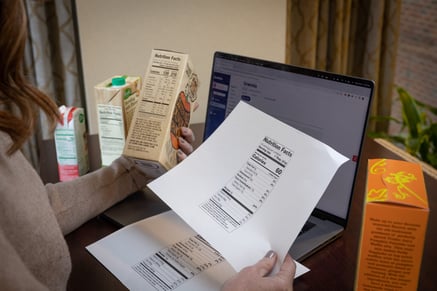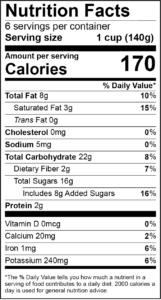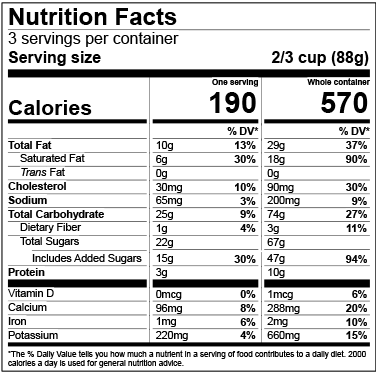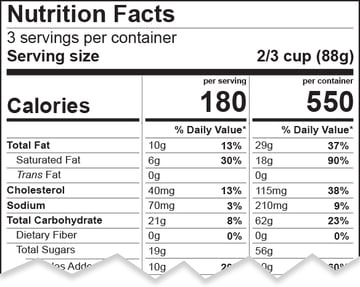 In the United States, you can find a variety of Nutrition Facts labels on food packaging. The Food and Drug Administration (FDA) (and in some cases, the US Department of Agriculture) creates and maintains guidelines for how companies must display Nutrition Facts labels, what nutrients are required, and how nutritional information should appear on a label.
In the United States, you can find a variety of Nutrition Facts labels on food packaging. The Food and Drug Administration (FDA) (and in some cases, the US Department of Agriculture) creates and maintains guidelines for how companies must display Nutrition Facts labels, what nutrients are required, and how nutritional information should appear on a label.
However, food packaging isn’t “one size fits all,” which means the standard Nutrition Facts label doesn’t always fit the packaging appropriately. And in some cases, the food inside the packaging may require additional ingredients or contain multiple servings. So, to help food manufacturers label their food and beverage products appropriately, the FDA has several labeling formats that adjust the size and shape of the Nutrition Facts panel to fit various packages and servings. In this blog, we’ll cover the formats and what is required for each.
Note for Genesis Foods users, keep an eye out for our tutorial links in each section for each label format!
Single Serving Label Formats
Food or beverages that are packaged in a single serving should use the standard label for most packaged items. However, if the package is too small for the standard label, food companies can also use tabular or linear labels. Whichever label you use, the values should be based on the entire contents of the package.
Standard Vertical Label
The most common, standard label format for food packaging is the vertical Nutrition Facts label (as shown below). This format is recommended as the primary format by the FDA unless packages have less than 40 square inches of vertical space or multiple servings. We cover the essential elements for standard label compliance on our blog: How to Create a Compliant Nutrition Facts Label.

Note for Genesis Foods users, you can learn how to view and select these formats in our Nutrition Facts FAQ webinar, at about the 26 minute mark.
Tabular or Horizontal Nutrition Facts Label
For food packaging that offers less than 3 inches of vertical space, or less than 40 square inches of total surface area (21 CFR 101.9(j)(13)(ii)), the FDA recommends using the tabular or horizontal format. This type of label can be found on packaged items that have more horizontal space than vertical space.
Notice, much of the formatting required for the standard, vertical label carries over to the horizontal version. Font sizes, serving information, calories in bold, nutrient set, and the footnote are all consistent between the vertical and tabular option.

Linear Nutrition Facts Label
If food packaging cannot accommodate either the standard vertical label or the horizontal label (less than 40 square inches of total surface area), then the linear format is allowed. This style is often seen on smaller individually packaged items but should contain most of the same information as a standard label. However, the linear label does allow some omissions, including the footnote, and some abbreviations are allowed.
Again, certain values are bolded to draw attention to them (serving size, calories, fat, cholesterol, sodium, and total carbohydrates), and the font size for calories is as large as “Nutrition Facts” at the top. The dimensions of the border can be adjusted to fit the size and shape of small packages.

(Note: If your food product only has a single ingredient, check out our blog post about how to create a single ingredient Nutrition Facts label.)
Aggregate Labels for Different Varieties or Flavors
If a food or beverage product comes in different flavors or varieties, the nutrition information must be listed for each. For example, a large box of cereal contains 3 different bagged varieties inside: cornflakes, all bran, and banana nut flavors. Each option has different calorie counts, ingredients, and nutrients, so the Nutrition Facts label on the outside of the box will need to account for each variety using an aggregate label.
In an aggregate label, the information for each item is listed in separate columns, as shown below.

Note for Genesis Foods users, watch our Aggregate Label tutorial to learn how to create this format in Genesis.
Combination Foods and Multi-Serving Labels
Sometimes packaged food requires additional ingredients before being eaten or includes multiple servings in a single package. In these cases, food packaging can use a dual column format.
Note for Genesis Foods users, to learn how to adjust panel sizes for your packaging inside the Genesis program, watch our tutorial on Dual Column Nutrition Facts and alternative labeling formats.
Dual Column Format for Multiple Forms of a Food
The Dual Column Label is used when food requires further preparation or is commonly prepared with another food, such as dry cake mixes or cereal with 2% milk. One column lists information for the product as packaged and one column for the product as prepared or as commonly eaten. In the example of cereal, the first column lists the cereal as packed while the second column lists cereal with milk (written above the calories amount).

Dual Column for Multiple Serving Sizes
A Dual Column Label is also required when a package contains 200 to 300 percent of the Reference Amounts Customarily Consumed (RACC). A dual column is optional when the package contains more than 150 percent to less than 200 percent of the RACC. The dual column label will show Nutrition Facts for one serving as well as the entire package.

Label Your Products with Confidence
Navigating FDA labeling guidelines can get complicated, and failing to follow guidelines can lead to an FDA Warning Letter and even a costly product recall. However, you can take the guesswork out of your labeling compliance needs with a software that provides the government guardrails to streamline label creation. Easily resize, reformat, or adjust your label’s appearance and access a comprehensive database of nutrients with Genesis Foods Formulation and Labeling Software from Trustwell.
Other posts you might be interested in
View All Posts
Food Labeling
34 min read
| February 23, 2022
Serving Sizes: Single-Serving Containers vs. Dual-Column Labeling
Read More
Food Safety
8 min read
| February 28, 2017
Safety & Sustainability: Do Your Suppliers Care Enough?
Read More
Food Safety
9 min read
| May 25, 2016

